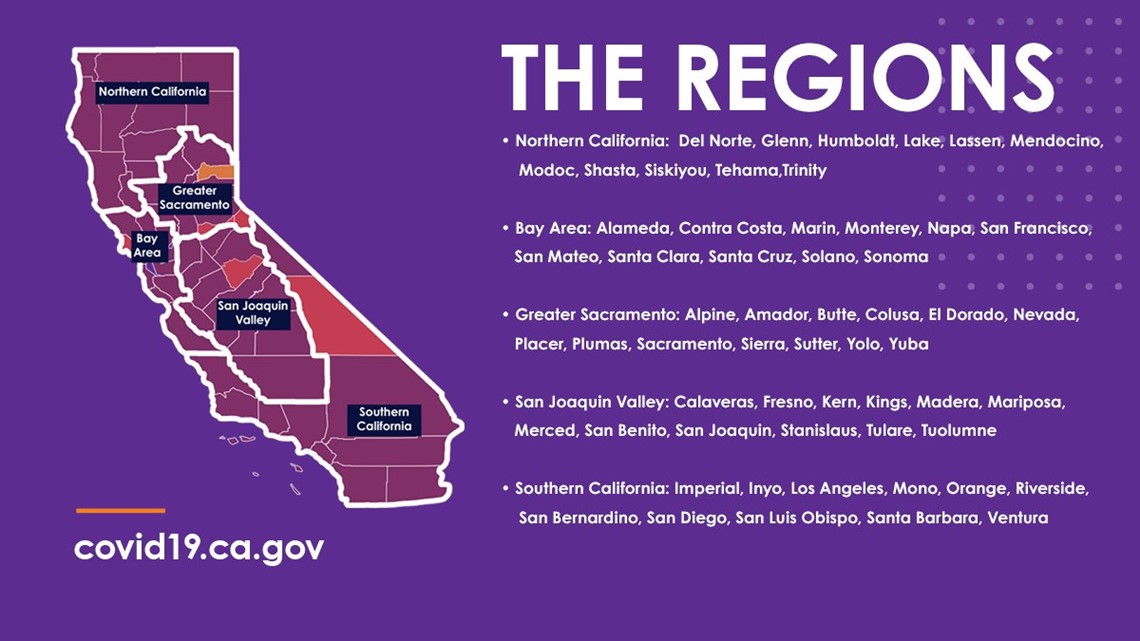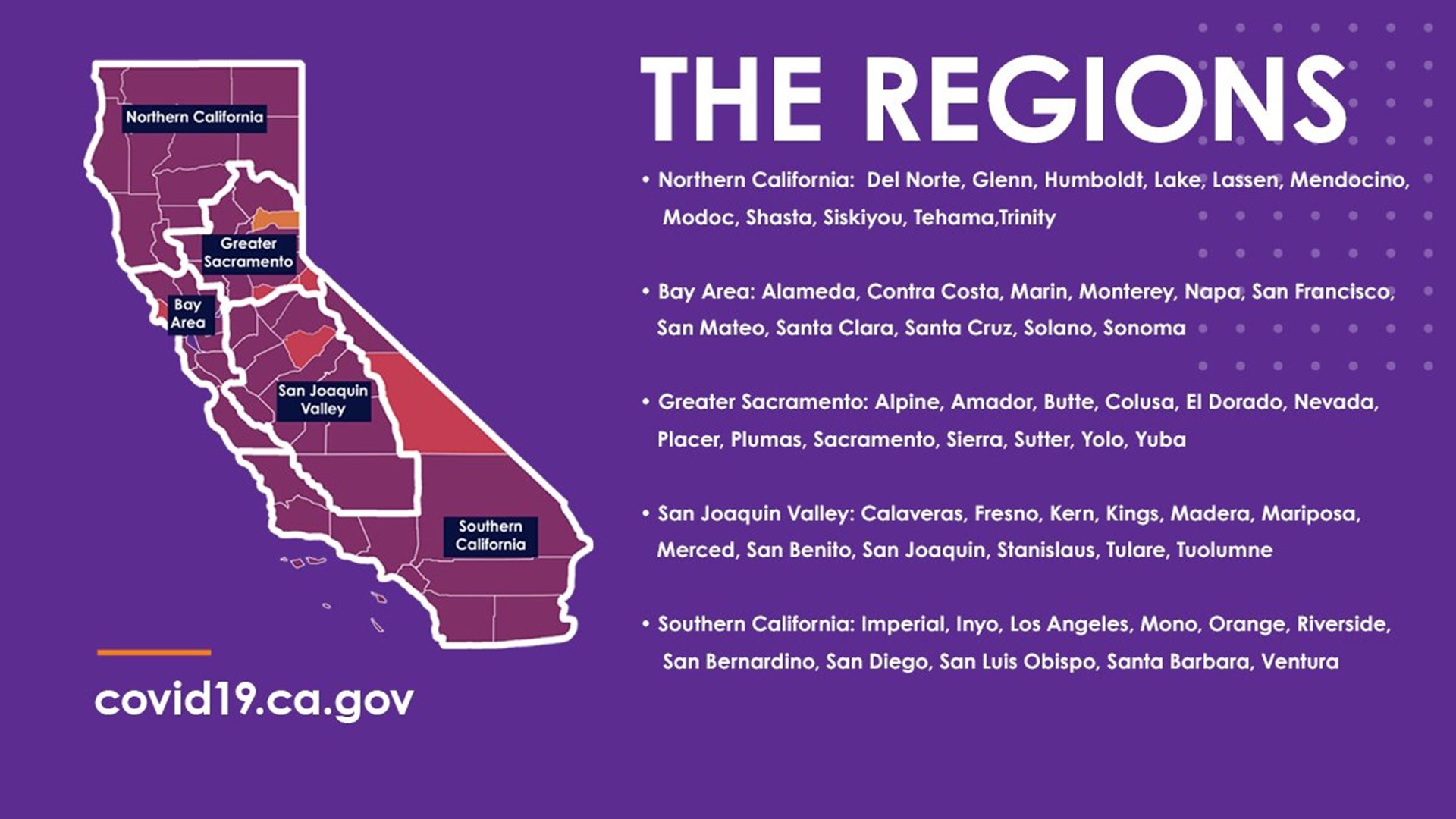SAN DIEGO COUNTY, California — Things sure do change quickly.
California Gov. Gavin Newsom on Thursday said most of the state will likely be under a new stay-at-home order within a day or two. It looks like the Southern California and San Joaquin Valley regions only needed a single day.
On Thursday, Dec 3, the ICU capacity remaining for the Southern California region was calculated at 20.6% by the state. One day later, that number dropped to a reported 13.1% dropping the region below the trigger of 15% capacity.
The other region that slipped below the threshold was the San Joaquin region which went from 19.7% ICU capacity remaining on Thursday to 14.1% on Friday.
Newsom announced new stay-at-home rules on Thursday that will trigger when a region’s intensive care unit capacity falls below 15%. At that time, no region met that criteria but Newsom said four of the state’s five regions are likely to meet that threshold soon.
When does this go into effect for Southern California region and San Diego?
According to the release sent out by the California Department of Public Health on Friday evening, if ICU capacity remains under 15% after Saturday’s update, the new restrictions go into effect at 11:59 p.m. on Sunday.
News 8 confirmed with San Diego County Supervisor Nathan Fletcher that the order will take effect at 11:59 p.m. on Sunday in San Diego County.
The Southern California region includes these counties: San Diego, Imperial, Inyo, Los Angeles, Mono, Orange, Riverside, San Bernardino, San Luis Obispo, Santa Barbara, Ventura
Current available ICU capacity by region:
- Southern California: 13.1%
- San Joaquin Valley: 14.1%
- Bay Area: 21.2%
- Greater Sacramento Region: 21.4%
- Northern California: 20.9%
What does this mean for the Southern California region and San Diego?
The order will remain in effect for at least 3 weeks and, after that period, will be lifted when a region’s projected ICU capacity meets or exceeds 15%. This will be assessed on a weekly basis after the initial 3 week period.
Which businesses will close?
The new round of stay-at-home orders will require many non-essential businesses in the impacted regions to close. According to the California Department of Public Health, those businesses include:
- Bars
- Wineries and breweries
- Personal Services
- Hair Salons and barbershops
- Indoor and outdoor playgrounds
- Personal care services
- Museums, zoos, and aquariums
- Movie theaters
- Live audience sports
- Amusement parks
Which businesses can stay open with safety protocols in place?
- Critical infrastructure
- Schools that are already approved for in-person learning
- Medical and dental care
- Childcare and Pre-k
Which businesses can stay somewhat open, but require 100% of people to wear masks?
- Outdoor recreational facilities: Allow outdoor operation only without any food, drink or alcohol sales. Additionally, overnight stays at campgrounds will not be permitted.
- Retail: Allow indoor operation at 20% capacity with entrance metering and no eating or drinking in the stores. Additionally, special hours should be instituted for seniors and others with chronic conditions or compromised immune systems.
- Shopping centers: Allow indoor operation at 20% capacity with entrance metering and no eating or drinking in the stores. Additionally, special hours should be instituted for seniors and others with chronic conditions or compromised immune systems.
- Hotels and lodging: Allow to open for critical infrastructure support only.
- Restaurants: Allow only for take-out, pick-up, or delivery.
- Offices: Allow remote only except for critical infrastructure sectors where remote working is not possible.
- Places of worship and political expression: Allow outdoor services only.
- Entertainment production including professional sports: Allow operation without live audiences. Additionally, testing protocol and “bubbles” are highly encouraged.
How long will this order last?
The order will remain in effect for at least three weeks and, after that period, will be lifted when a region’s projected ICU capacity meets or exceeds 15%. This will be assessed on a weekly basis after the initial 3 week period.
On Wednesday, California broke its record for new coronavirus cases reported in a single day. The state reported 20,759 new cases on Wednesday, shattering the previous record of more than 18,350 set just last week. A record 8,500 people are in the hospital. The state has fewer than 2,000 intensive care unit beds available, and officials have said they may be filled by Christmas unless the virus spread slows.
What about gatherings?
According to the Dec. 3 order, gatherings of any size are not allowed.



